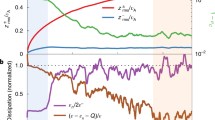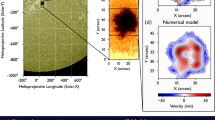Abstract
One of the main unanswered questions in solar physics is why the Sun's outer atmosphere is hotter than its surface. Theory predicts abundant production of high-frequency (10–50 mHz) acoustic waves in subsurface layers of the Sun1, and such waves are believed by many to constitute the dominant heating mechanism of the chromosphere (the lower part of the outer solar atmosphere) in non-magnetic regions2,3,4. Such high-frequency waves are difficult to detect because of high-frequency disturbances in Earth's atmosphere (seeing) and other factors. Here we report the detection of high-frequency waves, and we use numerical simulations to show that the acoustic energy flux of these waves is too low, by a factor of at least ten, to balance the radiative losses in the solar chromosphere. Acoustic waves therefore cannot constitute the dominant heating mechanism of the solar chromosphere.
This is a preview of subscription content, access via your institution
Access options
Subscribe to this journal
Receive 51 print issues and online access
$199.00 per year
only $3.90 per issue
Buy this article
- Purchase on Springer Link
- Instant access to full article PDF
Prices may be subject to local taxes which are calculated during checkout




Similar content being viewed by others
References
Musielak, Z. E., Rosner, R., Stein, R. F. & Ulmschneider, P. On sound generation by turbulent convection: a new look at old results. Astrophys. J. 423, 474–487 (1994)
Ulmschneider, P. Acoustic heating of stellar chromospheres and coronae. Astron. Soc. Pacif. Conf. Ser. 9, 3–14 (1990)
Ulmschneider, P., Theurer, J. & Musielak, Z. E. Acoustic wave energy fluxes for late-type stars. Astron. Astrophys. 315, 212–221 (1996)
Fawzy, D., Rammacher, W., Ulmschneider, P., Musielak, Z. E. & Stepien, K. Acoustic and magnetic wave heating in stars. I. Theoretical chromospheric models and emerging radiative fluxes. Astron. Astrophys. 386, 971–982 (2002)
Fossum, A. & Carlsson, M. Response functions of the UV filters of TRACE and the detectability of high frequency acoustic waves. Astrophys. J. (in the press)
Handy, B. N. et al. The transition region and coronal explorer. Sol. Phys. 187, 229–260 (1999)
Carlsson, M. & Stein, R. F. Does a nonmagnetic solar chromosphere exist? Astrophys. J. 440, 29–32 (1995)
Carlsson, M. & Stein, R. F. Formation of solar calcium H and K bright grains. Astrophys. J. 481, 500–514 (1997)
Carlsson, M. & Stein, R. F. Dynamic hydrogen ionization. Astrophys. J. 572, 626–635 (2002)
Dorfi, E. A. & Drury, L. O. Simple adaptive grids for 1-D initial value problems. J. Comput. Phys. 69, 175–195 (1987)
Gustafsson, B. A Fortran program for calculating “continous” absorption coefficients of stellar atmospheres. Uppsala Astr. Obs. Ann 5(6), 1–31 (1973)
Kurucz, R. L. & Bell, B. Atomic Line Data (CD-ROM 23, Smithsonian Astrophysical Observatory, Cambridge, Massachusetts, 1995)
van Regemorter, H. Rate of collisional excitation in stellar atmospheres. Astrophys. J. 136, 906–915 (1962)
Tobiska, W. K. Revised solar extreme ultraviolet flux model. J. Atmos. Terr. Phys. 53, 1005–1018 (1991)
Vernazza, J. E., Avrett, E. H. & Loeser, R. Structure of the solar chromosphere. III—Models of the EUV brightness components of the quiet-sun. Astrophys J. Suppl. Ser. 45, 635–725 (1981)
Goldreich, P., Murray, N. & Kumar, P. Excitation of solar p-modes. Astrophys. J. 424, 466–479 (1994)
Stein, R. F. & Nordlund, Å. Solar oscillations and convection. II. Excitation of radial oscillations. Astrophys. J. 546, 585–603 (2001)
Carlsson, M. & Stein, R. F. in Proc. Magnetic Coupling of the Solar Atmosphere Euroconf (ed. Sawaya-Lacoste, H.) 293–300 (IAU Colloquium 188, ESA SP-505, ESA, Noordwijk, 2002)
Sanchez Almeida, J. On the Sr I 4607 Hanle depolarization signals in the quiet Sun. Astron. Astrophys. (in the press)
Krijger, J. M. et al. Dynamics of the solar chromosphere. III. Ultraviolet brightness oscillations from TRACE. Astron. Astrophys. 379, 1052–1082 (2001)
Acknowledgements
This work was supported by the Research Council of Norway and by a grant of computing time from the Program for Supercomputing. We thank T. Tarbell, B. De Pontieu and the TRACE instrument team for their support.
Author information
Authors and Affiliations
Corresponding author
Ethics declarations
Competing interests
Reprints and permissions information is available at npg.nature.com/reprintsandpermissions. The authors declare no competing financial interests.
Rights and permissions
About this article
Cite this article
Fossum, A., Carlsson, M. High-frequency acoustic waves are not sufficient to heat the solar chromosphere. Nature 435, 919–921 (2005). https://doi.org/10.1038/nature03695
Received:
Accepted:
Issue Date:
DOI: https://doi.org/10.1038/nature03695
This article is cited by
-
Waves in the lower solar atmosphere: the dawn of next-generation solar telescopes
Living Reviews in Solar Physics (2023)
-
Small-Scale Dynamos: From Idealized Models to Solar and Stellar Applications
Space Science Reviews (2023)
-
Multiwavelength Studies of MHD Waves in the Solar Chromosphere
Space Science Reviews (2015)
-
Structures in the Outer Solar Atmosphere
Space Science Reviews (2015)
-
Ionized Plasma and Neutral Gas Coupling in the Sun’s Chromosphere and Earth’s Ionosphere/Thermosphere
Space Science Reviews (2014)
Comments
By submitting a comment you agree to abide by our Terms and Community Guidelines. If you find something abusive or that does not comply with our terms or guidelines please flag it as inappropriate.



